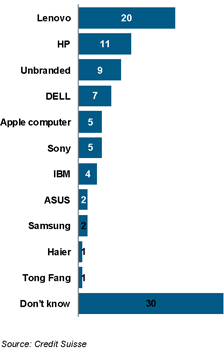Results from recent survey of more than 2,500 people in eight major cities in China reveals insight into Chinese lifestyle, mindset and technology spending patterns.
The survey was conducted across eight major cities in China in October and November 2009.
Survey findings resulted from responses by more than 2,500 survey respondents sharing individual and household-level information on a broad range of products and services, as well as more general information about income and attitudes.

This is the sixth year the survey has been conducted by Credit Suisse. Excerpts from analysis of the electronics and technology segment portion of the investment banking firm’s 230 page report follow.
Computers, TV
Ownership of personal computers (including desktops, laptops and netbooks) among the surveyed households was 89% in 2009. Among PC products, laptops increased most (from 26% to 45%). The penetration varies with household monthly income – from below 50% among low-income households (<Rmb2,000) to 97% among those with an income higher than Rmb8,000.
The intended electronics goods purchases or hot products consumers are most likely to buy over the next year are LCD TVs, notebook PCs, digital cameras and smartphones. Compared with last year’s survey (immediately after the Beijing Olympics), LCD has grown more popular in 2009.
Among PC brands most likely to be purchased, consumers prefer Lenovo (20%), followed by HP (11%), unbranded computers (9%) and…Dell (7%). (See Figure 1)
Figure 1: PC purchases among Chinese consumers

When looking at LCD flat screen TV brands most likely to be purchased, consumers like Sharp and Sony (both 10%) most, followed by Samsung (8%), among the LCD TV brands.
The average size of an LCD TV that consumers are most likely to purchase is 39 inches, up from 36 inches in 2008. The preferred sizes were mainly 42 to 45 inches (26%) and 31 to 36 inches (23%).
Handsets, smartphones
Average planned spending on mobile handsets by ‘current’ owners is Rmb2,205, higher than 2008’s survey results of Rmb2,145. 10% of these ‘replacers’ would buy a higher-tier phone (Rmb3,000 to Rmb4,000) and 6% would buy a very high-tier phone (Rmb4,000+).
Looking at current brands of mobile handsets among survey respondents, 42% of those surveyed who own a mobile handset own a Nokia, which dominates other brands, such as Samsung and Motorola.
Distribution for specific handsets are brand stores (32%) followed by electrical appliance stores (20%) as the main channels for distribution.
Better coverage is the dominant reason (54%) for mobile users to choose their current network.
80% of mobile handset users subscribe to China Mobile’s services (72% on 2G and 8% on TD-3G – a new service) for their current mobile phone network.
Better coverage is the dominant reason (54%) for mobile users to choose their current network.
30% of respondents say they would choose 3G service for their next mobile handset.
Average planned spending on mobile handsets is Rmb2,205 for current owners, higher than 2008’s Rmb2,145. 10% of replacers would buy a higher-tier phone (Rmb3,000-4,000) and 6% would buy a very high-tier phone (Rmb4,000+).
Digital camera is the most desired feature of a mobile handset, up strongly from last year. According to survey findings, the interests on some features surged, like Internet browsing, touch screen, QWERTY keyboard and email, which are generally related to smartphones.
Young people aged 20 to 29 are more interested in entertainment and connection features on their mobile handsets, while people 50 to 59 years old are more attracted by FM radio.
Internet, messaging, online buying
Internet penetration has been on the rise over the past three years reaching 75% in 2009. The access rate to the Internet is particularly high among young and well-educated people. (See Figure 2)
Figure 2: Internet access among Chinese by age and education

79% of those with Internet access use instant messenger software. QQ is the most frequently used and dominant (66%) chat tool, while the second most popular, MSN, is used by only 7% of total Internet users.
Clothes (27%) and books (16%) are the most popular goods and merchandize to be purchased online. (See Figure 3)
Figure 3: Favorite merchandise among Chinese consumers to purchase online

Almost half of all survey respondents purchased goods online in the past year, and the trend is rising fast. Taobao’s (a dominant e-commerce vendor) Alipay is the most popular payment method, instead of banks’ debit and credit cards.
Other points of interest
Other themes from the report include macro / multi-sector highlights such as China’s rich are becoming richer. The high income group (top 10% households) grew much faster than the average. Additionally:
The poor and the middle are still much better off. Even the income in the low income group is rising, particularly in the past two to three years, perhaps due to indirect benefits of improved farming profitability.
Chinese are saving less. The percentage of household income allocated to savings / investment dropped from 26% in Credit Suisse’s 2004 survey to 12% in the 2009 survey, while spending on housing increased significantly.
The property market is quickly changing. Ownership structure has changed in the last few years, with more people living in rented property and property bought in the market. First-time home buyers could surpass upgrade demand as the major buyers in the market in the near future.
Big-ticket items breaking out? Car ownership is rising, with consumers preparing a bigger budget for car purchases every year, despite car prices declining. The desire for larger LCD TVs also increases every year.
Foreign brands versus domestic brands – who will win the game? Consumer confidence in domestic brands is generally rising. Foreign brands still have advantages in areas like big-ticket items, luxury goods and tech products, while domestic brands are dominating the consumer service sectors, such as telecoms, Internet and travel. Foreign and domestic brands are even in the fast-moving consumer goods sector.
Additional sector-specific findings
Most Chinese prefer to take local airlines, but among foreign airlines, more consumers are aware of Singapore Airlines than Cathay / Dragonair, despite its limited routes in China.
55% of respondents expect property prices to rise in the next year, 27% don’t know, 9% expect no change and 8% expect prices to drop.
Get a degree, learn more about computers and English. 46% of adults enrolled in continuing education take degree accreditation courses. For vocational training courses, computer network technology is most popular. For language courses, 84% want to learn English.
73% of parents prefer to send their kids to state-owned schools for local education and the US is the most popular destination for overseas education (24%). Also, 44% of kids are taking training courses, mostly on subjects in school curriculum.
People buy stocks when prices go up, and vice versa 31% of respondents used the stock market as a means of investment in the 2009 survey (compared to 19% in 2008 and 30% in 2007).
Income growth for the 20 to 29 age group is still strongest. Respondents aged 20 to 29 experienced the strongest income growth in the past three years, and expect to see the highest growth in the next
three years.
Source: Credit Suisse, VentureOutsource.com, January 2010
Get list of EMS manufacturers for your requirements (Its free)
Save time and money. Find quality EMS manufacturers. Fast. Venture Outsource has a massive, global database of contract electronic design and manufacturing capabilities. Speak with a Provider Advisor.
“Was able to very quickly find details on the important elements of setting up EMS and ODM partnerships, talked with an advisor for personalized info on quality providers matching our requirements while getting up to speed quickly about the industry and connect with key staff from like-minded companies and potential partners. Great resource.”
— Jeff Treuhaft, Sr. Vice President, Fusion-IO
Advisors tell you matches we find for your needs, answer your questions and, can share EMS industry knowledge specific to your industries and markets.






